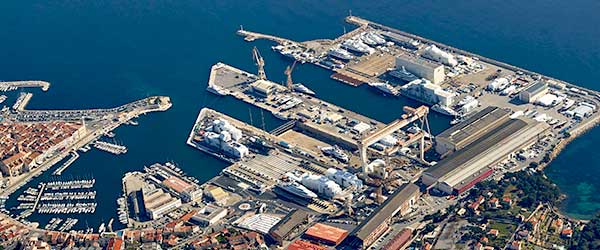La Ciotat Shipyards boasts a unique management style in the world of yachting,
which benefits from the stability of a public ownership and the agility of a private structure.
From shipbuilding to yachts refit,
the driver of a successful industrial development
La Ciotat Shipyards, formerly known as SEMIDEP-Ciotat, are a local public company, whose shareholders are:
-
- The Department of Bouches-du-Rhône (34,73%)
- The Metropole Aix-Marseille-Provence (34,65%)
- The South Region (17,93%)
- The City of La Ciotat (12,69%).
Created as the result of the 1994 agreements, La Ciotat Shipyards have witnessed the success of a voluntarist and partnership based policy of the reindustrialisation of the site formerly geared towards the construction of large industrial units (oil and LNG tankers, etc.) through a repositioning in the sector of repair, servicing and maintenance of large yachts.
The majority of the approximately one hundred million euros invested to date for the re-industrialization of the site are from private funds.
The unique management structure of the site, not commonplace within the yachting industry, is the subject of a political and extremely strong social consensus. It allows public body shareholders to retain control over major strategic choices of the site’s development while allowing reactivity suited to market requirements.




La Ciotat Shipyards find themselves today among the European leaders in the sector of refit and repair of yachts, with 8% to 10% of the global market, thanks to several major competitive advantages.
In addition to its exceptional industrial equipment, the site stands out in its ability to qualitatively meet the characteristics of the demand in the very specific yachting market, within 100 nautical miles of the French Riviera. Its natural assets are complemented by a technical expertise recognized around the world for the servicing of large yachts, with several resident operators and lead-contractors specialised in this market.
Each year, approximately a hundred yachts over 50m, or about 1/7th of the world fleet, come to La Ciotat Shipyards.
In addition to the shipyards specialized in the refit of Yachts, La Ciotat Shipyards also manage the “Old Harbor”, nested in the heart of the city, which has a small marina with a capacity of 700 berths, including 120 berths available for visitors, and 300 spaces allocated for dry storage.

2018: SEMIDEP become La Ciotat Shipyards
La Ciotat Shipyards have witnessed the success of a voluntarist and partnership based policy of the reindustrialisation of the site formerly geared towards the construction of large industrial units (oil and LNG tankers, etc.) through a repositioning in the sector of repair, servicing and maintenance of large yachts.

The 1994 agreements
The industrial history could have ended in 1988 without the intervention of a small group of 105 employees determined to save their worktool and to give an industrial and maritime future to the site. Like a David against Goliath remake, these “105 diehards” eventually win the fight.
On August 17 1994, an agreement was signed between the Government Representative, the Presidents of the Region and the Department, the Mayor of La Ciotat and Mr. Pierre Tidda representing the workers. This agreement, still acting as a true “Constitution” of the site to this day, is a commitment between the signatories based on two principles:
- Maintaining an industrial and maritime vocation for the site
- The unicity of its management
SEMIDEP-Ciotat is created in the aftermath to follow this ambitious roadmap and pilot the project, according to the principles of public service.

1988: the yards close-down
in 1978, the oil crisis and competition from Asia led to the first dismissals on the site. The production is again shifted towards the construction of oil tankers and other gas carriers, but also towards the repair of large vessels.
In 1982, the shipyards of Dunkerque, La Seyne sur Mer and La Ciotat are fused together in one company, the “Société des Chantiers du Nord et de la Méditerreanée” called NORMED. This unfortunate decision of the authorities, resulting from an incorrect strategic analysis, will seal the fate of the shipyards of La Ciotat.
On July 31 1988, the shipyards close-down … locking the “Monterrey”, still docked inside.

60's: La Ciotat, the flagship of the shipbuilding industry
The shipyard of La Ciotat will continue to develop their activities and skills, despite frequent changes of majority shareholders and therefore names … After “Messageries Maritimes”, they become “Société Provençale de Construction Navale” (SPCN) then “Chantiers Navals de La Ciotat (CNC).
The ships designed are larger and larger, more and more numerous, more and more complex to manufacture: the last super tankers built in the shipyard of La Ciotat were about 320,000 tonnes! In 1973, more than 5000 workers and employees work on the site.
It was at this time that the site’s largest infrastructures were created, including the great dry dock with its 250-tonne crane and its two 500- and 660-tonne gantry cranes.

19th Century: Development of steam navigation
From the nineteenth century, the activity grows with the development of steam navigation and the opening of transit to the colonies. In 1835, theharbor capacity is doubled with the construction of the pier “Bérouard”. That same year, Louis Benet, son of a wealthy shipowner from La Ciotat, takes over a small sailboat shipyard, and turns it into a modern company. As a savvy businessman, Louis Benet brings engineers and propulsion systems from England, and launches in 1836, the first French steamship in the Mediterranean, “Le Phocéen I”. It is also on the shipyard of La Ciotat that will be launched in 1847 “Le Bonaparte”, first steamship with a propeller and an iron hull in the Mediterranean. In 1848-1851, the industrial crisis leads Louis Benet to sell his company to the National Courier.

15th Century: From small fishing boats to steamships with propeller
The activity on the site begins in the fifteenth century with the construction of small fishing boats by local artisans. But soon these family businesses start to build “tartanes”, commercial cargo ships.




